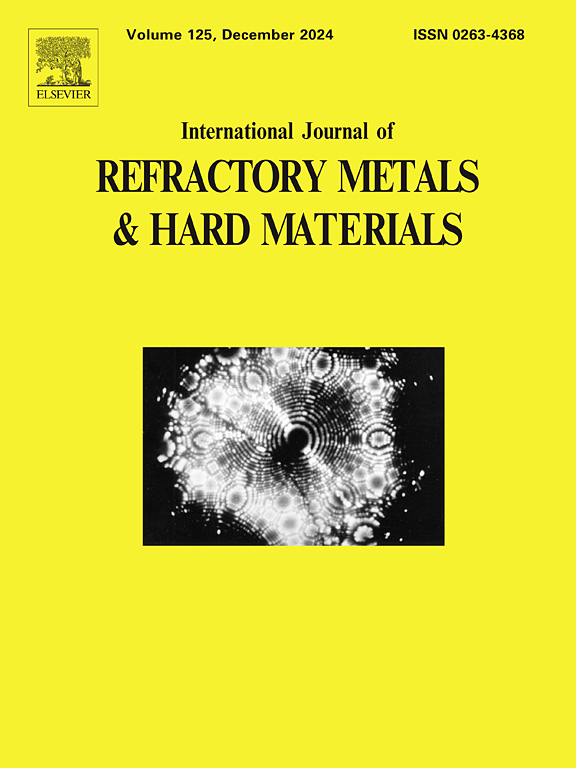Optimal interplay of charge localization, lattice dynamics and slip systems drives structural softening in dilute W alloys with Re additives
IF 4.2
2区 材料科学
Q2 MATERIALS SCIENCE, MULTIDISCIPLINARY
International Journal of Refractory Metals & Hard Materials
Pub Date : 2025-01-30
DOI:10.1016/j.ijrmhm.2025.107086
引用次数: 0
Abstract
Body centered cubic metals, such as tungsten (W), and their alloys exhibit superior mechanical properties such as high tensile strength and hardness, but their limited ductility contributes to brittleness and causes challenges in manufacturing and machining. While the ductilizing effect of Re additives in dilute W alloys is well reported, a fundamental understanding of the variations in elastic properties with temperature as well as the optimal composition that drives the softening mechanism, is warranted. Here we employ a combination of ab initio molecular simulations and experimental characterization to probe the structural softening in dilute W-Re alloys. We reveal that the coupled effect of charge localization around Re atoms and the predominance of softer phonon modes for a W alloy with 3.1 at.% Re results in the lowest values for the elastic moduli. We develop a probabilistic theory based on the likelihood of Re atoms to be located on the 〈111〉 family of slip directions, to explain the optimum fraction of Re that enhances the structural softening in the alloy. In essence, we corroborate that softening is realized through a reduction of intervening and mutually obstructing slip systems, interlinked with the electronic structure and lattice dynamics.
外加稀土的稀W合金中电荷局域化、晶格动力学和滑移系统的最佳相互作用驱动结构软化
体心立方金属,如钨(W)及其合金具有优异的机械性能,如高抗拉强度和硬度,但其有限的延展性导致脆性,并给制造和加工带来挑战。虽然稀土添加剂在稀W合金中的延性作用已经得到了很好的报道,但对弹性性能随温度的变化以及驱动软化机制的最佳成分的基本理解是有必要的。本文采用从头算分子模拟和实验表征相结合的方法来研究稀W-Re合金的结构软化。我们揭示了在3.1 at的W合金中,Re原子周围的电荷局域化和软声子模式优势的耦合效应。% Re导致弹性模量的最低值。我们建立了一个基于Re原子位于< 111 >滑移方向的可能性的概率理论,来解释Re的最佳分数,以增强合金中的结构软化。本质上,我们证实了软化是通过减少与电子结构和晶格动力学相互联系的相互阻碍的滑移系统来实现的。
本文章由计算机程序翻译,如有差异,请以英文原文为准。
求助全文
约1分钟内获得全文
求助全文
来源期刊
CiteScore
7.00
自引率
13.90%
发文量
236
审稿时长
35 days
期刊介绍:
The International Journal of Refractory Metals and Hard Materials (IJRMHM) publishes original research articles concerned with all aspects of refractory metals and hard materials. Refractory metals are defined as metals with melting points higher than 1800 °C. These are tungsten, molybdenum, chromium, tantalum, niobium, hafnium, and rhenium, as well as many compounds and alloys based thereupon. Hard materials that are included in the scope of this journal are defined as materials with hardness values higher than 1000 kg/mm2, primarily intended for applications as manufacturing tools or wear resistant components in mechanical systems. Thus they encompass carbides, nitrides and borides of metals, and related compounds. A special focus of this journal is put on the family of hardmetals, which is also known as cemented tungsten carbide, and cermets which are based on titanium carbide and carbonitrides with or without a metal binder. Ceramics and superhard materials including diamond and cubic boron nitride may also be accepted provided the subject material is presented as hard materials as defined above.

 求助内容:
求助内容: 应助结果提醒方式:
应助结果提醒方式:


